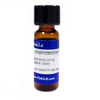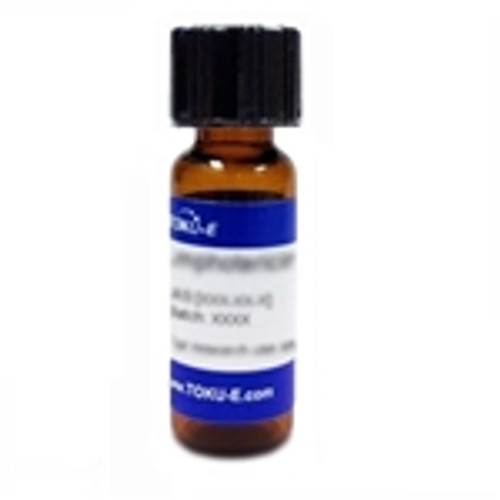Oligomycin E (26-hydroxyoligomycin B) is a minor analog of a class of macrocyclic lactones isolated from selected strains of Streptomyces spp. It is a non-selective inhibitor of mitochondrial F1F0 ATP synthase in eukaryotes. Oligomycins exhibit apoptotic cytotoxicity and mitochondrial toxicity. It can induce apoptosis in a variety of cell types. It is an important bioprobe to study the organization of ATPase on the mitochondrial membrane. Oligomycin E has weak antibacterial and antifungal activity in comparison to the other Oligomycins.
Oligomycin is a macrolide antibiotic complex from Streptomyces. It is an inhibitor of mitochondrial F1F0 ATP synthase. The Oligomycin complex was first reported in 1954, from a strain of Streptomyces diastatochromogenes from soil and highly active against fungi. The Oligomycin class includes the analogs/isomers A through G. Different isomers are highly specific for the disruption of mitochondrial metabolism.
Oligomycin can be used to study the mechanistic aspects of ATP formation in tumor cell biology and apoptosis. It can be used to demonstrate ‘proton leak’, the depletion of Δp in the presence of the ATP synthase inhibitor. Useful tool in cytochemistry to study the effects of ATP depletion.
Oligomycin E is soluble in ethanol, methanol, DMSO and DMF. Practically insoluble in water.
We also offer:
- Oligomycin (O037)
- Oligomycin A (O013)
- Oligomycin B (O018)
- Oligomycin C (O019)
- Oligomycin D (O020)
- Oligomycin E (O021)
- 21-Hydroxyoligomycin A (H032)
| Application | Oligomycin can be used to demonstrate ‘proton leak’, the depletion of Δp in the presence of the ATP synthase inhibitor. Useful tool in cytochemistry. Used to study effects of ATP depletion. |
| Spectrum | Oligomycin is active against Rhodotorula gultinis, Aspergillus niger and other molds. |
| Mechanism of Action | Oligomycin inhibits phosphoryl group transfer in mitochondrial membrane-bound ATP synthase (F1F0 ATPase), blocking proton translocation and leading to hyperpolarization of inner mitochondrial membrane. The result is that mitochondrial ATP is not synthesized, as this enzyme is responsible for ATP production in mammals via a rotary catalytic mechanism. After more than 50 years of studies on the binding site of Oligomycin, a team at the Rosalind Franklin University (North Chicago, IL) discovered that it binds to the subunit-c of the F0 portion of the ATP synthase. The residues involved in the binding site are conserved from yeast to humans (Symersky et al, 2012). |
| Microbiology Applications | A number of mutations in yeast have been shown to confer resistance to Oligomycin. |
| Eukaryotic Cell Culture Applications | Oligomycin is used to study ATP-linked respiration and for the maximal capacity respiration assay in astrocytes, at 1µM for MEF’s and 2 µM for astrocytes. It can be used to measure oxygen consumption in commercial kits such as the Mito Stress Test Kit (Agilent). The compound is serially injected to measure ATP-linked respiration. The test can help quantify parameters of mitochondrial respiration and identify mitochondrial dysfunction (Atzmon et al, 2018). |
| Cancer Applications | Mitochondria are regulators in apotosis, thus are a target for cancer research. Oligomycin was found to bypass doxorubicin resistance and block P-glycoprotein activity. P-glycoprotein causes multidrug resistance, and extrudes anticancer drugs to the extracellular environment using ATP. The result was that it triggered apoptosis in drug-resistant HepG2 cells (Li et al, 2002). Oligomycin can be used to measure oxygen consumption rate and extracellular acidification rates in breast cancer cell lines, contributing to our understanding of molecular pathways that contribute to breast cancer progression (Furth et al, 2018). |
| Plant Biology Applications | Oligomycin B can impair motility and induce lysis of grapevine downy mildew zoospores (Plasmopara viticola) in a dose- and time-dependent manner, with IC50 of 3.0 µg/ml (Dame et al, 2016). |
| Solubility | Soluble in ethanol, methanol, DMSO and DMF. Practically insoluble in water. |
| References |
Atzmon A et al (2018) Drug screening identifies sigma-1-receptor as a target for the therapy of VWM leukodystrophy. Front. Mol. Neurosci 11. 336 pp. doi 10.3389 Dame ZT, Islam MT, Helmke E, von Tiedemann A, and Laatsch H(2016). Oligomycins and pamamycin homologs impair motility and induce lysis of zoospores of the grapevine downy mildew pathogen, Plasmopara viticola. FEMS Microbiol Lett. 2016 363(16) pii: fnw167. PMID 27354061 Fitch ME, Chang CM and Parslow (2000) The BH3 domain is required for caspase-independent cell death induced by Bax and oligomycin. Cell Death Differ.7(4):338-349 PMID 10773818 Furth N et al (2018) LATS1 and LATS2 suppress breast cancer progression by maintaining cell identity and metabolic state. Life Sci. Alliance. 1(5):e201800171 PMID 30456386 Jastroch M (2010) Mitochondrial proton and electron leaks. Essays in Biochem. 47:53-67 doi:10.1042/bse0470053 Kobayashi K et al (1987) Oligomycin E, a new antitumor antibiotic produced by Streptomyces sp. MCI-2225.. J. Antibiot. 40:1053 Li YC et al (2002) Mitochondria-targeting drug Oligomycin blocked P-glycoprotein activity and triggered apoptosis in doxorubicin-resistant HepG2 cells. Pharmacol. 50:55-62 PMID 15211078 Miyoshi N, Oubrahim H, Chock PB and Stadtman ER (2006) Age-dependent cell death and the role of ATP in hydrogen peroxide-induced apoptosis and necrosis. Proc. Natl. Acad. Sci. USA 103(6):1727-1731 PMID 16443681 Peachman KK, Lyles DS and Bass DA (2001) Mitochondria in eosinophils: Functional role in apoptosis but not respiration. Proc. Natl Acad. Sci. USA 98(4):1717-1722 PMID 11172017 Raini G et al (2017) Mutant elF2B leads to impaired mitochondrial oxidative phosphorylation in vanishing white matter disease. J. Neurochem. 141(5):694-707 Smith RM, Peterson WH and McCoy E (1954) Oligomycin, a new antifungal antibiotic. Antibiot. Chemother. 4(9):962-970 Symersky J et al (2012) Oligomycin frames a common drug-binding site in the ATP synthase. Proc. Natl. Acad. Sci. USA 109(35):13961-13965 PMID 22869738 |








